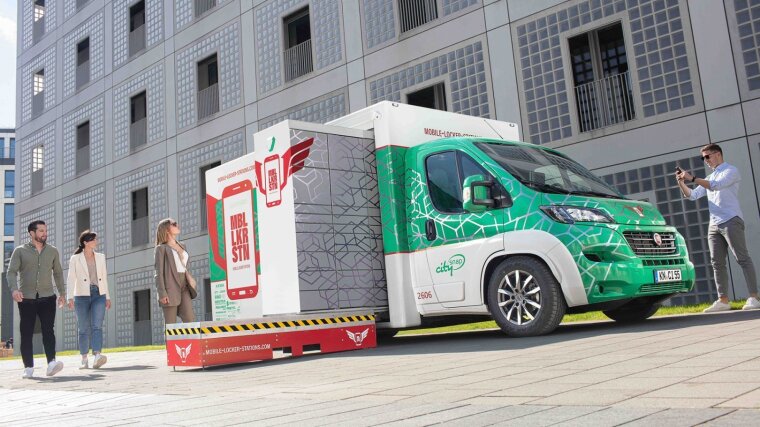
The dogs of the future won’t be barking at the postman – our parcels will be delivered by a mobile parcel station. Economic experts have conducted a study on novel delivery systems using specially developed optimization algorithms. Their aim is to make shipping processes as environmentally friendly as possible in our towns and cities.
By Vivien Busse
We are increasingly hearing about an overwhelming rise in parcel volumes, delivery vehicles parked in the middle of busy streets and tough working conditions for postal workers. So, it’s time for something to change on the »last mile«, the term used to describe the last leg of the supply chain between postal distribution centres and private households.
A number of technology companies, such as the Swiss manufacturer Rinspeed, are currently developing mobile parcel stations that are controlled by algorithms and drive almost right up to your front door. Prof. Dr Nils Boysen and his team from the Chair of Operations Management are helping to develop and improve those algorithms. Their most recent study compared innovative delivery systems from different providers using optimization algorithms.
Portrait shot of project leader Nils Boysen, Professor of Operations Management.
Image: Anne Günther (University of Jena)Algorithms for controlling mobile parcel stations
In the future, instead of the postman ringing our doorbell, we might get a smartphone notification telling us that a mobile parcel station has just arrived at the end of our street and the parcel can be collected there. For this solution to work, the parcel stations will have to know where to park and when.
»Stationary parcel stations have been around for a long time«, says Prof. Dr Nils Boysen, who is leading the research project. »But they’re still not very common, so people have to go a long way to find the nearest one and often prefer to collect their parcels by car rather than on foot. That defeats the purpose«.
Dr Stefan Schwerdfeger, who is responsible for developing algorithms in the project, adds: »Mobile parcel stations would come much closer to customers and stop at the end of their street. Everyone on the same street would then be able to collect their parcels on foot. That would be better for the environment and would also save logistics providers time and money, especially if the parcel stations were also able to drive autonomously in the future«.
Thanks to information provided by their project partners at Rinspeed, the university researchers have developed optimization algorithms that tell the mobile parcel stations where to stop and for how long. »That sounds simple, but numerous factors have to be taken into account«, says Prof. Boysen.
First of all, customers will have to say when they will be at home or whether they would rather collect their parcel somewhere else, such as near their workplace. In addition, customers must be given enough time to collect their items before the parcel station continues to the next address. And a station can’t just stop anywhere; safety must be ensured, says Boysen.
With these factors and various other requirements in mind, the researchers are drawing up routes for mobile parcel stations to navigate towns and cities. »Our aim is to deliver a set volume of parcels at the lowest possible cost and with the smallest possible environmental impact«, says Stefan Schwerdfeger.
Comparing different concepts for mobile parcel stations
The researchers are using their algorithms to compare different concepts from various providers of mobile parcel stations. Stefan Schwerdfeger explains it like this: »Rinspeed, for example, doesn’t want to have the entire vehicle parked at the end of the street with the parcel station attached – it wants the parcel station to be automatically unloaded and picked up again later. In the meantime, the vehicle can continue its journey and deliver other parcel stations«.
Nils Boysen adds: »Our algorithms then tell us whether such a concept is beneficial. In this case, we’ve found that costs can be cut significantly by unloading the parcel stations, especially if you want to give customers more time to collect their items. After all, you won’t always be able to drop whatever you’re doing to sprint to the parcel station«. In the future, the researchers want to continue using their algorithms to improve deliveries over the last mile and help to deliver parcels to people in towns and cities as sustainably as possible.
Original publication:
Who moves the locker? A benchmark study of alternative mobile parcel locker concepts (2022), http://dx.doi.org/10.2139/ssrn.4063099 External link
